
by ANNA McNAY
Fabienne Verdier (b1962, Paris) produces large, abstract paintings, characterised by bold, gestural brushstrokes, made using enormous, suspended vertical brushes of her own construction. She combines knowledge and philosophy, learned during 10 years studying with old masters in China, with western expressionism, to create explosions of movement and life on the carefully prepared, layered canvases. Her physical and performative creative practice experiments with reproducing energy lines – invisible forces that are continually evolving – often echoing, albeit unintentionally, natural forms, such as branches, rivers and lightning flashes.
Verdier’s work has been shown alongside a huge variety of artists, including Auguste Rodin, Willem de Kooning, Ellsworth Kelly, Cy Twombly and the Flemish primitives, but watching Verdier in the act of painting most calls to mind Jackson Pollock with his vertical method of pouring, dripping and swirling the paint, using contraptions such as turkey basters.
.jpg)
Fabienne Verdier in her studio, 2016, courtesy Waddington Custot.
In 2014, Verdier was the first visual artist-in-residence at the Juilliard School in New York, where she undertook live studio experiments seeking to answer the question of whether painting and music, in the moment of creation, might be “played” simultaneously. Her works in Rhythms and Reflections, her current exhibition at Waddington Custot, London, derive from this experiment, materialising rhythms and reflections on the canvas. They further explore the movement of the body in space and its encounters with lines of force in the landscape as one walks or strolls about.
Speaking to Studio International at the opening of the exhibition, Verdier was palpably excited about her methods and explorations, and full of creative energy.
Anna McNay: Having read about your life and career, I have so much I want to ask you, Fabienne. Before we talk specifically about your current exhibition, Rhythm and Reflections, at Waddington Custot, can we start with a little about your background and your time in China?
Fabienne Verdier: Of course. My history and background is very special; I am an intrepid woman, a bit of a rebel maybe, in the face of institutions and school and, well, everything. Being a painter means attending a school of free thinking, a form of resistance to today’s world, organised and managed by means that defy our understanding – by algorithms, equations and artificial intelligence.
.jpg)
Fabienne Verdier in her studio, 2016, courtesy Waddington Custot.
AMc: Your initial education in art, from your father, who was also an artist, was quite intense, locked in a room for eight hours a day, being taught drawing, painting, sketching and perspective. Looking back, are you grateful to him for this strict initiation?
FV: When I was a little child, when my parents divorced, I became very sad and fragile. I am the eldest, with four brothers and sisters. My father left the family when I was six and made his life on a boat on the Seine, close to Museé d’Art Moderne, the ballet, and the Palais de Chaillot. This, for me, was a huge first art experience because, every weekend, when I visited him, I always went to the museums and that universe, that artistic environment, and the experiments that artists were doing at that time – Yves Klein with the Blue Monochrome, the machines of Jean Tinguely – that atmosphere of imagination was so inviting to me that I decided intuitively that I really wanted to be in that universe too. From that moment, at six years old, I decided this is the place I want to be, and my life began there.
I told my father that I wanted to be a painter. “Are you crazy?”, he said. “It’s too difficult!” But he taught me, nevertheless. He taught me in a very classical way with an easel. He really wanted me to understand and recreate reality traditionally with three-point perspective. I never accepted that. I said: “But, Dad, it’s not my perception of reality.” Then he was totally crazy with me. I began to rebel against that traditional view.
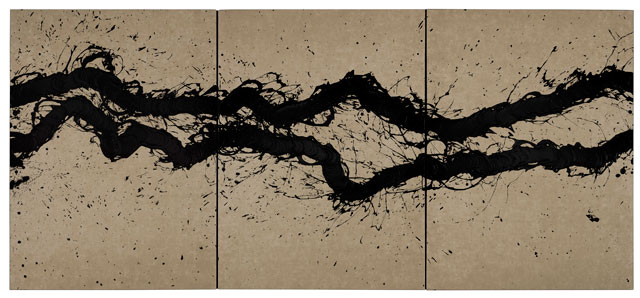
Fabienne Verdier. Cadence, 2016. Acrylic and mixed media on canvas, 183 x 407 cm. Courtesy Waddington Custot.
AMc: After studying at the École des Beaux-Arts of Toulouse and completing a five-year course in just three years, you left France to study in China.
FV: Yes. When I was at art school, I had the same problem. The professor asked me: “Fabienne, is it boring for you to be here and sketch?” I said: “Yes, I’m very bored.” So I left the school, very young. My intuition told me that my interest was in the question of what life is. Life is movement, and movement is spontaneity. So my question was how to represent the spirit of life? How to paint this reality in constant change? I realised that I would not get the training I needed in France. Some of the older teachers suggested I should go to Asia. So then I left France and went to the Sichuan Fine Arts Institute.
AMc: You managed to talk the mayor of Toulouse into organising an exchange of students, if I’m not mistaken?
FV: Yes.
AMc: At first you were singled out and given special treatment as a foreigner, but you fought against this and, finally, so as to escape the predominant Russian school of socialist realism, managed to persuade the old master Huang Yuan to take you on as his student. With him, you travelled to remote places and learned not just calligraphy and art, but also philosophy and poetry. How long were you there for overall, and what was life like?
FV: It was not easy for me there as a female. I thought at the beginning I would just do the foundation training for one year, but I ended up staying 10 years. It was really very difficult because, in France, I had been one of the best students in my school, but when I arrived in China, they laughed at me. They said: “Well, the people said that you are one of the best students, so we will see.”
The masters gave me a piece of white paper and a brush, and said: “OK, we will see what your level is as a painter.” They told me to paint, there and then, my spiritual view of tree branches. I looked at them and said that if they wanted me to do that, I would need to use my sketchbook and do something traditional, thinking about the composition. They laughed at me and said: “OK, we rebegin. You will have to forget all your culture and you will rebegin.”
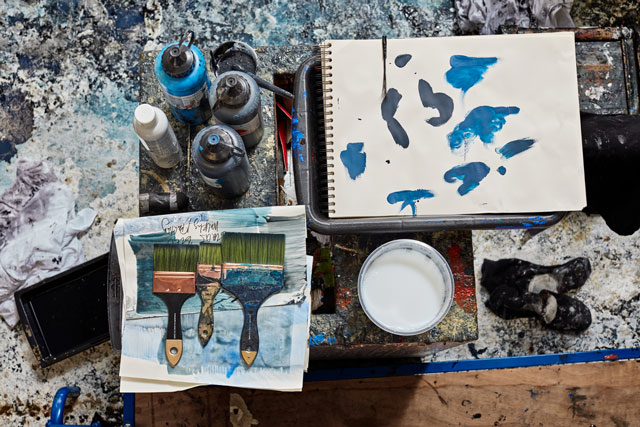
Fabienne Verdier studio, 2016. Photograph: John Short. Courtesy Waddington Custot.
So the first step was like being a child: I forced myself to think in another way, to learn the Chinese dialect and to be totally different and to look at reality in a totally different way. It was very difficult because there is such a huge difference between east and west. It took a long time. Then, of course, when I came back to France it was difficult for me because I had a completely new view of the world. I was totally changed from our culture and I no longer saw our great masters in the same way. I rediscovered great masters such as Rembrandt and Turner, men who used paint in a spontaneous way. Even in a small watercolour, the brush marks were such sudden events and an immediate perception of life.
AMc: What were some of the key lessons you learned while in China?
FV: The most important thing I learned was the act of painting vertically. I left behind the act of painting with an easel in the traditional way. It is so important because, in the vertical act of painting, you have a reserve in the brush, in the tails of the brush. I came to understand that all the forms found on Earth and in the universe are shaped by the laws of gravity. So, in the act of painting, I have devoted my life to that idea.
The brushes I used in China were small, but I understood that if I created a much bigger, giant brush, I could play with that idea of gravity. When I paint with a big brush like that now, the brushstrokes are in harmony with nature because they share the same source: gravity. Since I returned from China in 1992, I have developed the idea of a suspended brush. I have had incessant revelations and I have invented different tools to combine the two cultures and to invent a new kind of spontaneous abstract painting.
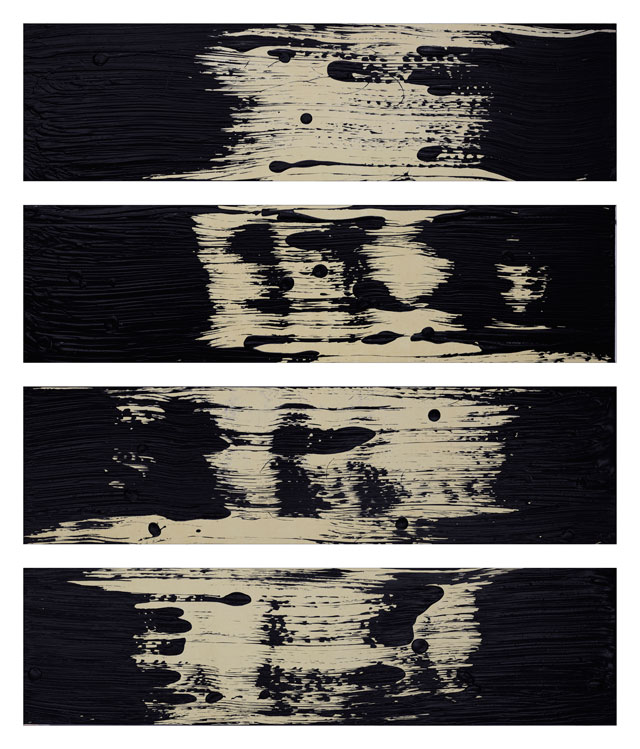
Fabienne Verdier. Fractale-scapes I, 2016. Acrylic and mixed media on canvas, 135 x 113 cm. Courtesy Waddington Custot.
AMc: Is the suspension purely because the brushes are so heavy?
FV: They’re heavy, yes, because now I’m working with up to 100 litres of paint. So I have invented a mechanism that allows me to be free in the space with the big brush. I really want to share the spontaneity of a sudden event, a line and energy without beginning, without end. I want to help you to reconnect with the energy of the world.
[Verdier pauses to draw a diagram of the brush with its ink/paint reserve]
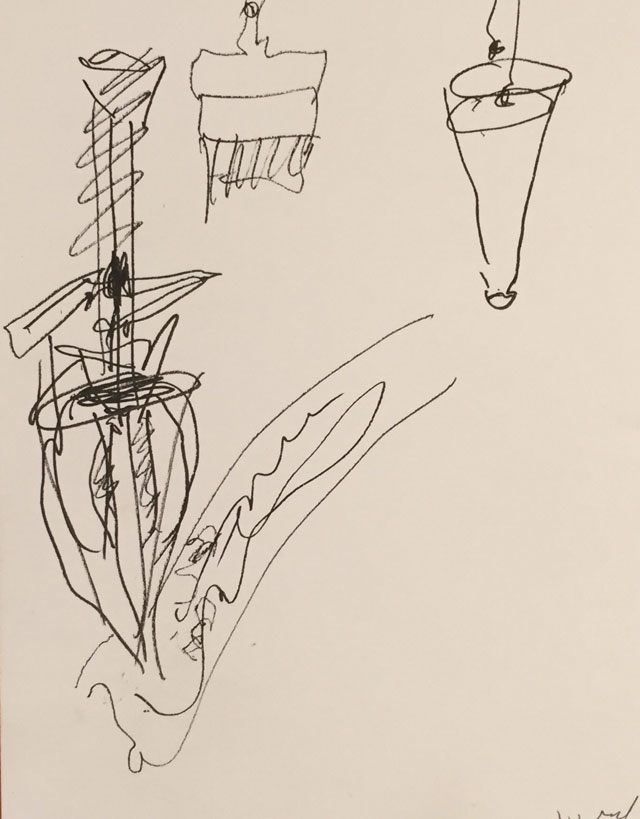
Diagram of Fabienne Verdier's homemade brushes by Fabienne Verdier. Photograph: Anna McNay.
Here, there is an inner reserve. I created a kind of funnel and here is my paint. So when you paint an energy line, you have a good reserve of paint, and you can go here and there, and nourish your energy line. You can play with the fundamental force because you are in the vertical act of painting.
Recently, I had the idea of connecting a bicycle’s handlebars to the suspending chain mechanism and this incredibly amazing thing happened. Usually, when you paint a line, you have two dimensions but, with the bicycle handlebar, suddenly I had much more freedom and space for my body and I acquired a kind of velocity, and suddenly my brushstrokes on the painting had an additional third dimension. The force you give to your brushstrokes creates the form. I have no interest in copying natural forms, but I really want to capture the hidden force and create the form by itself. When I discovered this new language, this new abstract language, I was afraid, because it’s such a strong language. I do not paint forms, I paint invisible forces that are continually becoming/evolving into forms. I am not interested in reproducing forms. Paul Klee said: “Art does not reproduce the visible; rather, it makes visible.” I am like a water diviner, harnessing natural forces. It’s the mystery of the living that I am drawn to. I visited my garden one day in winter and discovered that, when there is no foliage, the forms of the branches have exactly the same expression of the fundamental force line as my paintings. And lightning as well, it has the same form. And landscapes with rivers. I said: “Oh, my God, it’s not so bad!” So I’m very happy now to present these works for the first time.
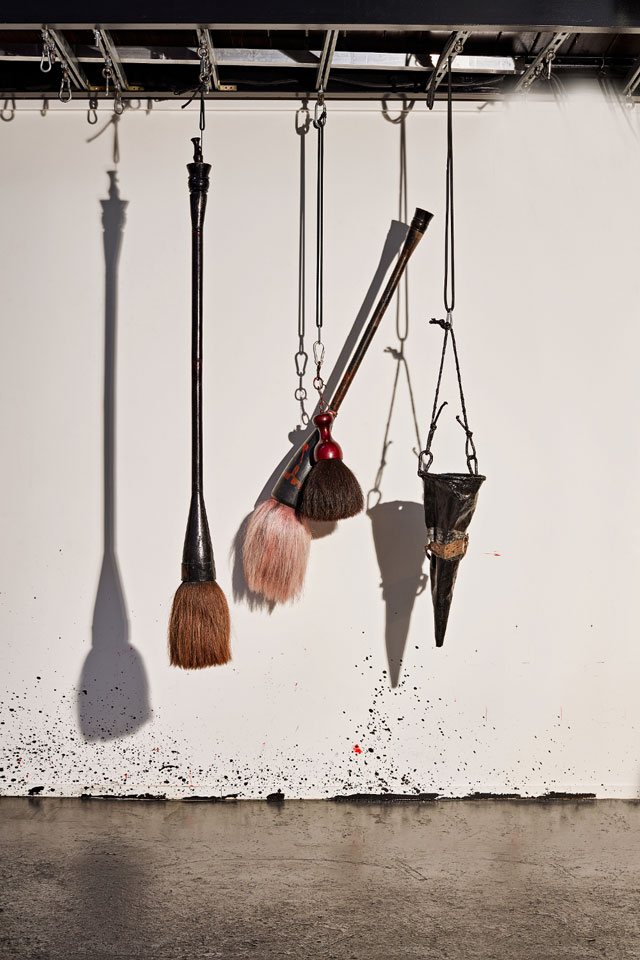
Fabienne Verdier studio, 2016. Photograph: John Short. Courtesy Waddington Custot.
AMc: The most part of your work appears to be black on white, quite monochrome, but here you have introduced vibrant colours.
FV: Yes, I live in the countryside near Paris and sometimes I love the natural energy of colour, and sometimes there is a feel of totally red, or totally yellow. This is a kind of minimal approach, but I love to have the sudden shock, a new poetic journey.
What I am presenting in London is the result of my most recent explorations. I’ve been examining two new territories. First, there is the materialisation on the canvas of rhythms and reflections that I perceive as a constant flickering of energies in movement. The more I explore the notions of energies, the more I realise that the phenomena of reflection, refraction, diffraction, dispersion, oscillation and propagation are at the core of our perception of almost all forms around us. It is this sort of perpetual undulation that interests me. I’m also showing my first monochrome noir works. They conjure up the celestial night, because I often walk across my garden at night, from my house to the studio and back, and I often have that kind of celestial impression of the deepness of the sky and the universe. These paintings all begin with silver, because I want to feel the brightness coming through. Layer after layer, I try to create the deepness of the celestial, using paint and also creating some microstructure with layers of cerography. I have the impression that, with each step, the walker encounters lines of force in the landscape that begin to move as he moves his body through space, so I looked for a way to relive and experiment on the canvas with these emotions arising from the linear wandering of the rambler. Painting helps us to attain a form of liberation and to continually rebuild ourselves by discovering the mysteries deep within us and our world.

Fabienne Verdier studio, 2016. Photograph: John Short. Courtesy Waddington Custot.
AMc: In 2014, you were the first visual artist-in-residence at the Juilliard School in New York, where you undertook live studio experiments seeking to answer the question of whether painting and music, in the moment of creation, might be “played” simultaneously. Did you reach a conclusion?
FV: I created a sort of laboratory there. I left my studio – I was really a very solitary painter – and it was a real shock for me, my encounter with sound and musicians and another kind of abstract language. Music is another kind of abstract language. This shock made me doubt myself, and all the things I believed in, the aesthetic I had created over 30 years. When I heard and experimented with music, I realised I had a new vision. A new structure appeared in my mind. I said to myself: “I have to forget all the things that I do and know, and I have to re-begin once again.”
Before the Juilliard, I thought that the brushstroke was my matrix. With that one brushstroke, in constant transformation, I could speak, I could transmit the older form of the world, by transforming that energy line. But then the musicians invited me to play with them. I said: “But I am a painter!” This confrontation with the sound space of musicians and composers totally revolutionised my previous thinking about forms – the immersion in musical composition, its rhythms, its sound structures, its counterpoint lines and harmony. By playing with musicians, new pictorial and sound waves appeared, liberated from my brush by immediate improvisation. In painting at the heart of rhythms in incessant transformation, I understood that by “composing” structures made by weaving movements and counter-movements, variations of energies were emerging on the canvas, suggesting reflections of reality. When I just breathe in the rhythm, when I paint like exhaling, inhaling, exhaling, inhaling, like a kite, reality just appears by itself. The music helped me to find that mystery in the rhythm. As the Mexican poet Octavio Paz said: “Rhythm is not a tempo: it is a vision of the world.” What I am trying to do today through this work is to make poetically visible this reality that is constantly coming into being.
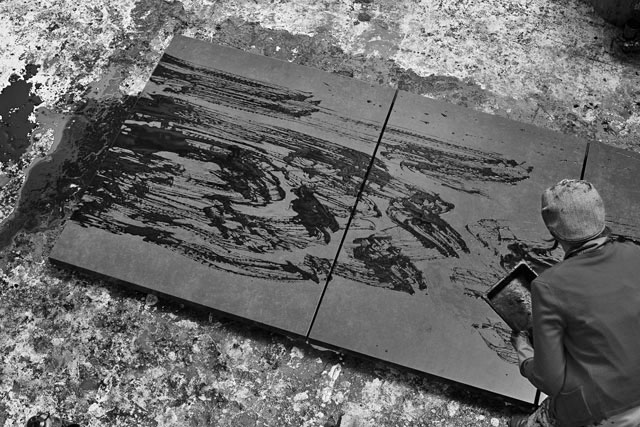
Fabienne Verdier studio, 2016. Photograph: Robert Short. Courtesy Waddington Custot.
AMc: Did you work to music that you knew already?
FV: No, they really pushed me beyond my limits. I discovered a lot of different music. I worked with Kenny Barron, the great master of jazz improvisation. I felt really close to the musicians because, throughout my life, I’ve tried to express a kind of spontaneity in my soul, like a musician. We work in the same way: we have the same kind of professional background. But I never would have imagined that we could exchange such a profound and deep thing without saying any words. I hear the sounds that they give to me and they also picture a dynamic line. It’s opened up new territory, for them and for me, something we never thought about before. We exchanged something amazing.
.jpg)
Fabienne Verdier in her studio, 2016, courtesy Waddington Custot.
AMc: Do you now listen to music when you make your work?
FV: There is no need to listen to music because, when you experiment with music, that music continues to play, to construct, to build in your brain. It just stays and nourishes you. So, yes, for sure, music helped me to create something, a kind of life and energy line. I really want to help people reconnect with a sense of life, a constantly becoming thing. My creative process most often involves three phases. First, I research: thoughts and observations in notebooks, making sketches and sometimes inks on paper. Then, I prepare the canvas by applying several layers of pigment and glaze to obtain the desired degree of vibration, saturation and depth of colour. Finally, standing directly on the stretcher and using tools of my own invention, I shape the paint matter to express fundamental life forces.
AMc: Do you still maintain a practice of Taoist meditation before you begin to work?
FV: All my work is a kind of meditation. When I create a background for a work, I do so layer after layer. I first try to create a kind of vibration. Then I stay with the background for a long time before having the intuition of how the line will cross the space. I destroy a lot of my work. It’s very rare to successfully encounter real life in it and, if it doesn’t work, I destroy it by fire. Becoming a painter takes time. Even if “painting is a mental exercise”, as Leonardo da Vinci said, the battle of the painter is to refuse mental habits, the mental reflexes that he has built up during his working life. It is the hardest thing imaginable. And if you have talent, then the danger is even greater. It is amazingly difficult not to surf on it. You have to be very careful. Beyond virtuosity, what is there? To get there means constantly questioning one(my)self, every morning in the studio. It means being capable of a receptiveness that is almost cold, that allows you to open yourself to the unknown and unexpected, to anything that comes along.
• Fabienne Verdier: Rhythms and Reflections is at Waddington Custot, London, until 4 February 2017.